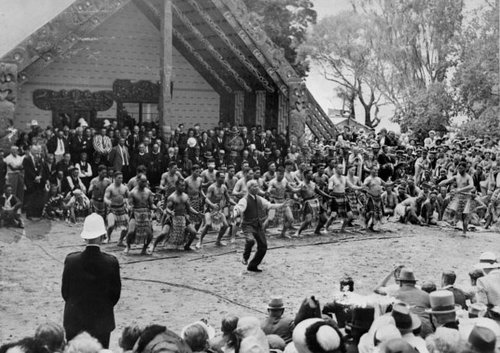
By Sarah Johnston
The original recording of his speech, outlining Māori grievances and calling for greater Pākehā understanding, is held in the radio collection of Ngā Taonga Sound & Vision.
Hero image: Apirana Turupa Ngata leading a haka at the 1940 centennial celebrations at Waitangi. Alexander Turnbull Library Wellington, New Zealand (Ref: MNZ-2746-1/2-F)

Centennial Tower, New Zealand Centennial Exhibition, Wellington, at night. Eileen Deste. Alexander Turnbull Library, Wellington, New Zealand (Ref: 1/2-004305-F)
The 1940 centenary marked 100 years since the signing of the Treaty and despite taking place in the midst of World War II, it was celebrated by events around the country, including the Centennial Exhibition in Wellington.
The official emphasis of the centennial was on celebrating a century of European progress, and Māori contributions were sidelined, with scant acknowledgement of breaches of the Treaty by the Crown in the intervening years.
On February 6th 1940, an elaborate re-enactment of the Treaty signing ceremony was staged at Waitangi, with the National Commercial Broadcasting Service recording and broadcasting much of the ceremony live to the nation.
Following the re-enactment, there was a further ceremony to mark the opening of a new national wharenui in the Treaty grounds. Known as Te Whare Rūnanga, this building was carved in a variety of styles, designed to reflect all iwi and be a truly national meeting house.
Northern chief Tau Henare and Sir Apirana Ngata had led the project to have the wharenui built, with funding and support from several different iwi.
The Broadcasting Service also covered the opening of the meeting house, and recorded speeches made by the Governor-General Lord Galway, Prime Minister Peter Fraser and leading Māori figures such as MPs Haami Rātana and Eru Tirikatene – and Sir Apirana Ngata.
As organiser of the event, he begins his speech with some housekeeping, asking those guests with blue luncheon tickets to go to the meeting house and those with red tickets to go to the marquee with Paddy Webb. (There is laughter at this as Webb was a well-known left-wing politician.)
Sir Apirana then moves onto a more serious subject matter, leaving the audience in no doubt that Māori were not necessarily in the mood for celebrating, saying they had approached the Centennial year with much misgiving and listing their grievances; lands lost, powers of chiefs humbled, Māori culture scattered and broken.
He was a media-savvy leader and was no doubt well-aware that his speech was being broadcast. He had worked with the Broadcasting Service already, using his friendship with founding director of broadcasting Professor James Shelley, to urge the broadcaster to record important hui such as the investiture of Princess Te Puea Hērangi and the opening of Turongo House at Ngāruawāhia in 1938.
Later, he went on to record commentaries about the many significant haka and waiata recorded at these events, saying it was “to put on record Māori songs and chants before the generation who knows these things passes away.” ¹
But on 6 February 1940, Sir Apirana was concerned more with the future of his people, as you can hear in his speech:
Speech by Sir Apirana Ngata, from Re-enactment of the Treaty Ceremony at Waitangi (06 Feb 1940). Ngā Taonga Sound & Vision Radio Collection, all rights reserved. To enquire about re-use of this item please contact sound@ngataonga.org.nz.
[1.] Sir Apirana Ngata – personal message to Professor James Shelley, from Opening of Tamatekapua Meeting House. Part 1 of 6, 25 Mar 1943. Ngā Taonga Sound & Vision Radio Collection.